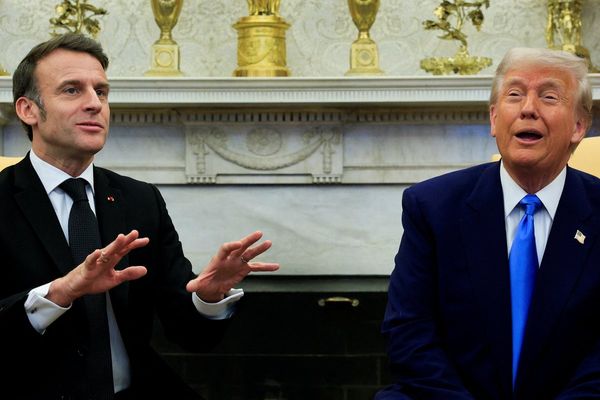
Interest rates fell last week as the Federal Reserve declined on Nov. 1 to boost its key rates again. Oil prices fell. So, too, did gas prices. And Friday's jobs report suggested a softening labor market.
Despite war in the Middle East and eastern Europe, stocks surged in their best weekly performances in more than a year.
If you're a crabby investor, you may grouse, "So what!"
The better question may be: How long will stocks go up? It could last into New Years, although risks exist that could derail things in 2024.
Related: Goldman Sachs is bullish on these 25 stocks
If that seems far-fetched from the gloom of recent weeks, consider this:
The Standard & Poor's 500 Index, the Dow Jones industrials ^DJI, and the Nasdaq Composite Index were up 5.9%, 5.1%, and 6.6%, respectively, for the week, their best weekly showings since the fall of 2022.
The things people want to see in place are materializing: a stable jobs market, lower inflation, and the possibility of stable and, one hopes, lower interest rates.
Perhaps more importantly, the rally was not just about big stocks, whose huge gains fueled the gains for the big indexes while other stocks basically wallowed.
The small-cap Russell 2000 Index jumped 7.6% on the week. The S&P Small Cap 600 Index ^SML jumped 7.5%.
Related: Cathie Wood reveals the truth behind Elon Musk's fruitless self-driving predictions
A note: Without the gains from just the seven richest S&P 500 stocks, the index would have been negative on the year on Oct. 30, wrote S&P Senior Index Analyst Howard Silverblatt this past week. With the seven, the index was up about 10%.
So, thank the forces that have produced this potential.
The Fed. The central bank stopped raising rates after its July meeting. Its key federal funds rate has been 5.25% to 5.5%, and the CME FedWatch tool puts the odds of a rate increase at its December meeting at less than 5% and less than 10% in January. Fed Chairman Jerome Powell told a news conference on Nov. 1 that the Fed has made no decision on December — and officials didn't talk about it at their meeting on Oct. 31 and Nov. 1. The body language, The Wall Street Journal observed, suggested the Fed really may be done raising rates.
Falling interest rates. The 10-Treasury yield briefly topped 5% on Oct. 23 and has since dropped back to 4.52%. That's not the Fed. That's traders who believed inflationary pressures are starting to soften. But softening is just a start. Bankrate.com's Saturday (Nov. 4) report on mortgage rates put the national average at 7.94%, down from 8.03% a week earlier. The rate had been 7.02% on July 21. The market for mortgages is still challenging, Bankrate said. That's why home sales have fallen in the last year. But the direction at least has changed.
The October jobs report. Issued on Nov. 3 (and subject to revision), the report noted a slight uptick in the unemployment rate to 3.9% as well as a softer-than-expected gain in payroll employment. That has surprised the entire Fed and just about every economist who studies the U.S. It is not clear what the impact of the United Auto Workers' new contracts will have on overall wage trends.
Easing inflation pressures overall. On this, we turn to gasoline prices, which continued to fall this past week and are down more than 11.7% after peaking at $3.881 a gallon on Sept. 18. Falling crude oil prices, down nearly 6% this week, are driving the declines.
Little impact from conflicts in Ukraine and the Middle East. At least so far, this fall. A widening war between Israel and its neighbors, could change that very quickly.
The week's big winners fuel the rally
The last few weeks have been uglier than you might think.
Consider Barchart.com's daily tracking of new highs and lows daily. Stocks hitting their 52-week highs fell to just seven on Oct. 20. New 52-week lows were 553. On Oct. 23, the next trading day, new 52-week highs totalled 14. New lows: 713.
The worst day since the Fed started its inflation-fighting campaign was Sept. 23, when just eight stocks hit 52-week highs, compared with 1,404 with 52-week lows.
The abrupt turn in stocks in the week just ended has seen the gap narrow and reverse, a bullish sign. On Nov. 3, winners were ahead of losers 117 to 81, after 43 straight negative days.
The Dow's 1,643.7-point gain on the week came as none of its 30 components showed declines.
Though Tesla TSLA was up 6% on the week, it is still slogging a bit. It fell 19.7% in October.
As a result, the week offered some additional fuel to add to confidence: outsized gains for October on less visible stocks. That's a sign confidence is returning to Wall Street.
Delivery service DoorDash DASH jumped 30.1% on the week and is up 23.4% for the month. Bank of America BAC added 12.9% for the week and is up 7.9% so far this month. (It's off 14.2% for the year.)
Moog, a smallish maker of aviation components, jumped 11.7% on Nov. 3 alone and is up 14.3% so far in November and 51% on the year. A strong third-quarter earnings report fueled broadcaster Paramount PARA to a 15.44% gain on Nov. 3. It's up 26.8% for the month in just three trading days.
Risks: The Fed, government shutdown, geopolitics
The markets turned around primarily because of the Fed and the reality that, when push comes to shove, the bond market and the price of money rule all.
Risk 1: What the Fed does. The Fed could decide to raise interest rates in December. But, try as it might, the Fed can be mercurial.
Risk 2: Geopolitics. The Ukraine-Russia War shows no signs of settling, no matter how many wild and very unconfirmed suggestions that Russian President Vladimir Putin is either dead or close to it. Add to that mix, Israel's violent reaction to Hamas' violent attacks on Israeli communities. There are calls globally for a cease fire, which Israel has resisted. The third issue to watch is China's designs on Taiwan and whether that turns into a military problem. Lastly, never forget North Korea.
Risk 3: A U.S. government shutdown. Also, the 2024 elections. Many expect a shutdown later this month, and the question is: do Democrats or Republicans blink first? The elections season looks to be especially bitter.







